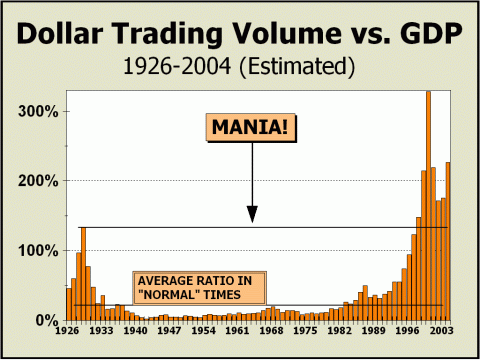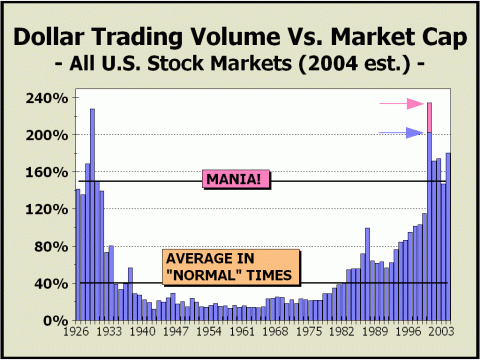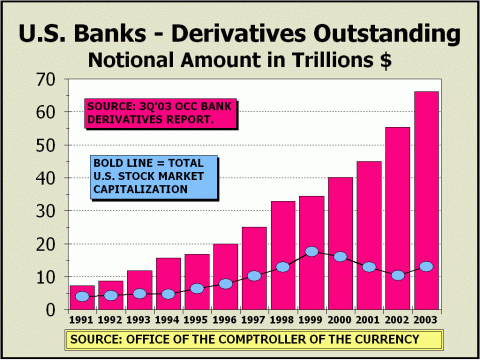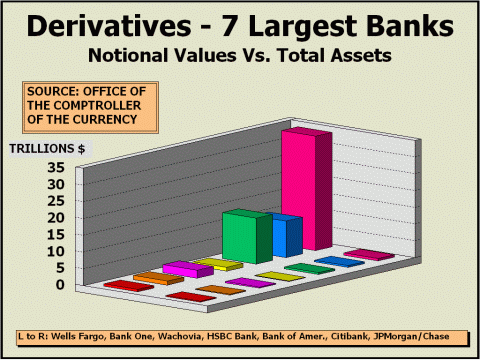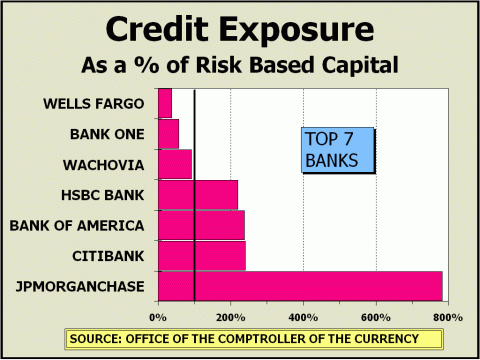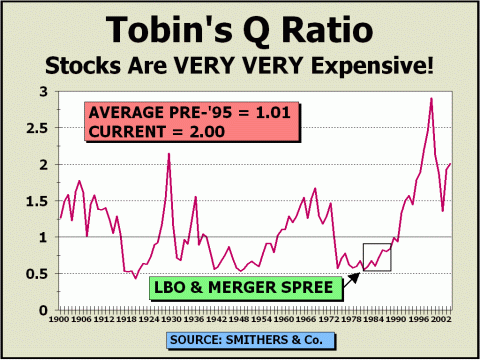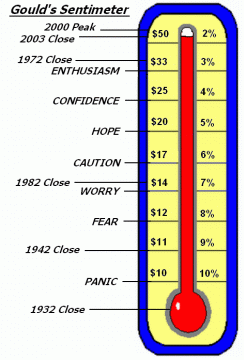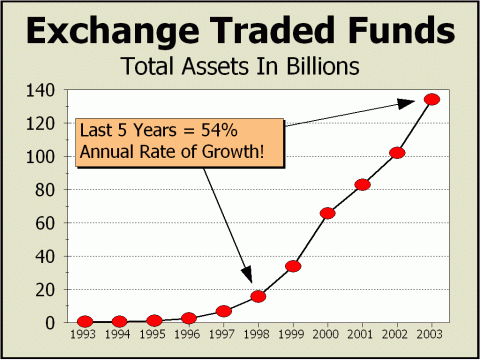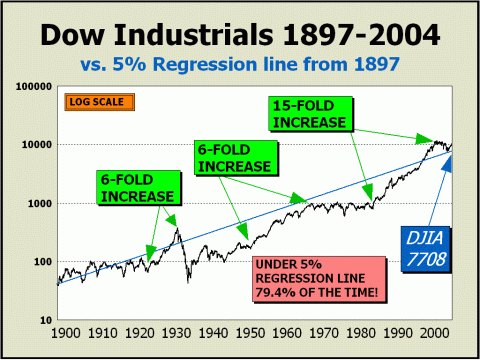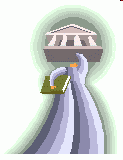
|
- ADDITIONAL PROOF OF THE GREATEST STOCK MARKET MANIA OF ALL TIME - DATED FEBRUARY 7, 2004 A SPECIAL REPORT BY ALAN M. NEWMAN, EDITOR LONGBOAT GLOBAL ADVISORS CROSSCURRENTS SOMETIME IN APRIL, THIS PAGE WILL RECEIVE ITS ONE MILLIONTH VISITOR. OUR ENTIRE WEBSITE HAS HAD OVER 2-1/2 MILLION VISITS SINCE WE COMMENCED PUBLISHING ON JANUARY 15, 1999. IF YOU BELIEVE YOU HAVE FRIENDS WHO MIGHT BE INTERESTED IN VISITING, PLEASE LET THEM KNOW. WE'RE ALWAYS OPEN AND EVERYONE IS WELCOME. |
|
She’s got a ticket to ride, She’s got a ticket to ride, But she don’t care. I don’t know why she’s ridin’ so high, She ought to think twice...." Ever since the great collapse of 2000-2001, Nasdaq has cut back drastically on the data services they once offered and we have had to do an immense amount of legwork to keep up with our Dollar Volume Trading tallies. It would be far simpler to use the measure focused on by Jim Bianco of Bianco Research and by Ken Safian of Safian Investment Research, which simply divides total stock market capitalization by Gross Domestic Product. But the point is not only that stocks are expensive, it is that they are traded to death! This is the nature of speculation and it is certainly the epitome of a stock market mania. If stocks simply went up in value rapidly and no one sold or traded (relatively speaking), that would actually scream from the rooftops that higher prices were fair because folks were reluctant to part with their shares. But that is not what is occurring. In the month of January, Nasdaq traded nearly 2-1/4 billion shares per day, proof that participants were quite thrilled to part with their shares. Yes, buyers stood ready but in all likelihood, sellers could not bear to be out and just rotated their assets into other holdings. The players all believe they have a ticket to ride the gravy train and have no cares at all about this next phase of the greatest mania of all time. They ought to think twice. They're not. This is not the investment market that existed from post-World War II and into the late 1960s. This is not the first stage of the great bull market from 1982 to 1990. This is an animal with entirely different stripes. Not a bull. Not a bear. A veritable stock market mania and quite probably, the most profligate mania of all time.
- VELOCITY - As it turns out, we were a bit more off on last year's final estimate of DTV than we would have liked, but further examination uncovered some data we could not previously find. Although we may still be off by a tiny bit, we believe the year end tally for 2003 is now quite accurate. It is our initial estimate for 2004 that we are unsure of. However, if trading remains at the same pace and prices do not range too far from where they currently are, the bar for 2004 will be about as high as it now stands - in the stratosphere and second only to the year 2000. It is inconceivable that trading could again even remotely approach the pinnacle of 2000. After the fallout of 2001 and 2002, it is a fair assumption that some of the players were burnt sufficiently and are now smart enough to remain gun shy. Thus, the bar you now see representing what 2004 may generate is far more important than the roughly equal level of 1999. Back in 1999, the sky was still the limit. Who knew what the top could be? Now, we know. It makes no sense to assume that the bar in 2004 can travel much higher than it is now. Given the backdrop of the 78 years and especially what occurred beyond 1999 and 2000, we believe it is quite safe to assume we are still very much ensconced in a stock market mania.
DTV versus total market capitalization is another measure of how intensely speculation has gripped participants. At the peak in 2000, our measure ran to a higher peak than 1929, testament to a market gone mad, driven by rapid trading and a constancy of higher prices. We arbitrarily chose the 150% turnover level as the boundary for an "official" mania but in truth, there is no official definition, only an assumption. Although 2002 traded a tick below the mania level, newsletters writers according to Investor's Intelligence displayed more bears than bulls in only six weeks while stocks were down 45% from their highs. Given the huge decline in prices, it appears that most participants were still trying to pick the bottom. During this year, where the Nasdaq Composite index fell as much as 43% and still finished down 32%, bulls were above the 50% level for twenty weeks. Bears never ranged above 42.3% and were above 40% in only three weeks. Imagine how sentiment might have been if prices had only fallen modestly! Given that so much money is now devoted to the trading of derivative instruments of index futures and stock options, it can be argued that without said derivatives, trading in the underlying stock issues would be significantly higher. Thus, DTV versus total stock market capitalization could conceivably be understated in relation to where it soared in 1929.
- FINANCIAL WEAPONS OF MASS DESTRUCTION - Once or twice each year, we focus on derivatives, those unwieldy beasts that Warren Buffet termed potential "financial weapons of mass destruction." Those of you who have read our opuses for the last few years well know our position on derivatives, which we firmly believe pose the threat of a financial earthquake equivalent to a 9 on the Richter scale. We began writing about these threats after the crash of 1987, when the world was perhaps as little as fifteen minutes from a financial collapse and wrote again at length after the LTCM fiasco in 1998, when the world was certainly only a day or two from a financial collapse. The principal threat from derivatives is that no one has any idea of how intricately the daisy chain is linked or just how any potential problems can unfold and like the most virulent of viruses, infect the financial world both speedily and fatally. On October 19, 1987, when the futures pits opened in Chicago, Wells Fargo stepped in and unloaded six separate $100 million lots of S&P futures. That's all it took to catalyze the worst day in stock market history. In the fall of 1998, Long Term Capital management believed it was bigger than the market. And the flawed strategy of just one hedge fund necessitated the brokering of the Chairman of the Federal Reserve between major banks and brokerages to stave off a financial collapse that was already reverberating through a daisy chain of $2 trillion in derivative products. Although Mr. Greenspan continues to believe that derivatives have changed the world for the better, we believe otherwise. Given the rapid rate of expansion in derivative use, their non-regulated status, and our relative ignorance of how they are intertwined (like in 1987 and 1998), a disaster of enormous scope is likely to surface at some point. It has been amply demonstrated that the policy of the Federal Reserve is to deal with crises AFTER the fact, not before. The measures of success to date offer us no confidence that they can deal with what in the first place, must be unknowable. Simply put, derivatives have grown far more rapidly than our comprehension of how they work.
All our data is taken from the Office of the Comptroller of the Currency and can be found at www.occ.gov. As our chart above clearly illustrates, derivative growth is in a mania by itself. We hasten to remind that the bars shown are only for the U.S., whereas it has been posited that derivatives worldwide may now exceed $120 trillion. The charts and numbers we show are just the OCC's "official" tally. The Bank of International Settlements in Basel, Switzerland estimates that nearly $170 trillion in notional values of OTC derivatives now exist! The annualized rate of growth in the U.S. since 1991 is 20.1%, far exceeding growth in the Dow Industrials at 10.5%, the S&P 500 at 9.6% and even Nasdaq at 10.8%. You want to see a long term mania at work? Just look at the chart below. Belief in product fuels the fires of derivative growth. New product means commissions and the pot at the end of the rainbow for those financial engineers who are masters of the arcane craft of creating "needs" where none need exist. An example of this sleight is the options and futures contracts that are planned for the VIX, itself a mere indicator of volatility with no tangible value whatsoever. Notional values of U.S. derivatives now measure five times total stock market capitalization and six times GDP. If a worst case scenario unfolds at any point, the derivative market is now huge enough so that the fallout could be catastrophic.
Our next chart details the credit risk suffered by the seven largest U.S. bank holders of derivatives. The vertical line placed at 100% is equal to the entire risk based capital of the bank. Although you might be tempted to ponder that only JP Morgan might be in harm's way, consider that their derivative portfolio has counter-parties, some of whom could conceivably drown if enough went wrong. Now that JPMorgan/Chase is taking over Bank One, the picture changes, but only to a minor degree. If you stare at the chart long enough, you may see the real reason why the merger is taking place, so that the capital of the surviving entity capital is no longer quite as compromised as it was before. But all the same, the exposure is monumental. Ironically, the combination will result in the bank “growing” into the 10th largest U.S. company, if our computation is correct. This will mean even more indexing money thrown at JPMorgan/Chase/BankOne, blindly and with absolutely no regard by indexers for the exposures maintained by JPM‘s derivative portfolio. We would think a reasonable investor would be put off by the sheer size of the portfolio, and invest elsewhere, even if it meant giving up whatever “opportunity” was offered by the new and larger JPM. In this case, larger via indexing equates to more inefficiently priced shares and the larger derivative portfolio exposure in any event, carries with it, the opportunity for higher risk. Whatever profits JPM is capable of, we'll gladly forego ownership of the shares in the interests of a more conservative stance. Finally, consider that the seven banks shown comprise derivative portfolios that total more than $64.2 trillion in notional values while total assets are only $2.7 trillion. We have always surmised that a worst case scenario could impact as much as 2% of the notional values involved. If we are correct, the worst case scenario could impact roughly half of the seven major bank's assets.
- DOUBLE WHAT THEY'RE WORTH! - The most remarkable part of the indexing equation is that professional investors are now totally convinced that valuations have permanently changed. Inflows into large caps have been incredibly robust for years and has lifted their valuations to extreme levels. But the process did not take place overnight and the gradual incline in valuations has gone on for so long that it has achieved a consensus of acceptance. But if larger stocks can "rightfully" achieve these valuations, smaller stocks can also achieve the same, or perhaps even higher valuations - so the thinking goes. Thus, we see an environment where the impossible has actually occurred! Professionals are now able to throw 100 years of Tobin's Q ratio out the window, a measure devised by James Tobin of Yale University, a Nobel Laureate in Economics. Mr. Tobin hypothesized that the combined market value of all the companies on the stock market should be about equal to their replacement costs. The individual calculation is the market value of a firm's assets divided by their replacement value. For close to a century and until the mania, such has been the case, with the ratio offering solid proof of Tobin's theory by averaging just 1.01. Note how the great Leveraged Buyout and Merger spree of the early 1980s took place when Q values were under 1. The impetus to buy undervalued stocks was then immense. But since the mania began (by our count in 1995), Q has averaged a rather robust 2.05, meaning one would have to be literally quite crazy to buy something one could replace for half as much! But that's what a mania is all about, isn't it? At the current reading of 2.00, buying U.S. stocks is about as reasonable as paying $30,000 for a 1998 Jeep Cherokee. We'll pass.
- A "HOT" MARKET - Edson Gould passed away in 1985 but left this mortal coil with a prophesy that would not be fulfilled until five years after his passing. As early as 1974, when the Dow was laboring in the midst of the worst bear market since the fallout of the 1929 crash, Gould offered an interviewer a long term projection for the 1980s Dow to "perhaps 3000, 4000 or 5000." The Dow achieved a high print of 2745 on August 25, 1987, close enough. Gould later refined a November 1979 forecast to "over 3000" in 1990. At the time, the Dow was trading at a tad above 800 and gloom was widespread. Nevertheless, on July 16th and 17th, 1990, the Dow closed at 2999.75 and briefly traded above the 3000 mark for five consecutive days. Gould's prophesy may have been the most incredible of all time. Gould's 1979 report entitled, "The Sign of the Bull," focused on several fundamentals, one of which he called the "Sentimeter." In the master prophet's own words, "One of our most valuable concepts for projecting intermediate and long term stock market tops and bottoms is our Sentimeter," also known as the price-to-dividend ratio. Gould displayed his Sentimeter in the form of a thermometer, detailing the yield basis at the price of each $1 in dividends. Today's feature picture is Gould's Sentimeter as pictured in 1979, with a few minor changes. Note Gould's description of the levels of emotion, stopping at "Enthusiasm." We would venture that he never once believed that emotions could surge as high as they did during the current mania. Even at the 1929 peak in September, yields were higher than they were in either 2003 or 2000. The Sentimeter stood substantially lower at major bear market bottoms like 1982 and 1932. Although we have not marked 1974, that bottom was at the 6% level. Although Gould's article appeared 25 years ago, just to prove that some things are just as they were then, he wrote, “Dividends are what a stockholder receives, that which he can spend. Earnings, however, are often illusory, something further confused by different and often changing accounting methods. Here one year, gone the next, through restatement or whatever.” [italics ours] Maybe even frauds? And here we see one prime reason why dividends are no longer important, because it makes life much easier for corporate accountants. You cannot pay out what you do not earn. Thus, the investment world has been stood upside down to satisfy the manic dispositions of Wall Street analysts, corporate managers and even the investment professionals who place the public's money into equities at valuations never seen before in stock market history. Is it any wonder that insider sales have outstripped purchases by a hundred fold or more when stocks return so little, except claims of profits? Is it any wonder that even these claims are no longer uniformly defined for all companies and for all circumstances? Gould wrote, "Once a stockholder gets his dividend check, the accountants can never take it away." Currently, only 15% of the S&P 500 issues pay dividends of 3% or more, the level at which Gould considered evidence of "enthusiasm." Incredibly, and despite the brutal lessons taught by Enron and Worldcom, the money managers of the world insist upon price performance, price performance, price performance, at any cost, and without any regard to dividends. New scandals such as that of Parmalat, will not end until the rationales for investment revert to their historical norms. There is still far too much pressure brought to bear on corporations to fudge their numbers in order to lift their share prices, which makes everyone happy, especially the Fed. For now, as Gould's Sentimeter clearly illustrates, this market is about as hot as it can get.
- MASSIVE INEFFICIENCIES IN STOCK PRICES - We recently counted more than 130 different ETFs ranging in size from the gigantic SPDRs, representing the S&P 500, with $38.2 billion in assets, down to iShares Global Technology Sector at a mere $6.7 million in assets. However, the top 25 ETFs comprise more than $101 billion in assets and are destined to grab enormous chunks from mutual fund companies in the years ahead. However, the unfortunate problem with ETFs is the precisely the same despicable circumstance we perceive with indexed mutual funds. ETFs are typically either index funds or "sector" funds. Either way, stocks in the trust are usually weighted by market capitalization. Like index funds, this means the larger a stock is, the more likely it is to be purchased, either by the trust itself, or by a firm that deposits the trust’s securities to take delivery of trust shares. As a consequence, the massive inefficiencies already visible in the pricing of U.S. stocks are not only likely to continue, but will clearly worsen in the years ahead if this trend is left unchecked. There can also be no question that the growth in index funds and ETFs accounts for a large part of the increase in program trading activity, and there can be no doubt that the influence of individual investors, like that of individual company prospects, has simply faded from any vestige of importance. ETF growth has amounted to 54% annualized over the last five years. If ETF growth remains steady at 50% for the next decade, these entities will comprise more than 60% of total U.S. market cap. If we only assume 35% growth, ETFs will still equal more than 20% of U.S. market cap. How incredible has the ETF phenomenon become? Consider that the Fidelity Structured Mid Cap Value fund's largest holding is the iShares Russell Midcap Value ETF. That's right, folks, now you pay Fidelity to manage your money to buy an ETF. Still more for the grist mill. Of the top 25 issues traded by volume on the Amex in December, 16 were stocks and 9 were ETFs. However, dollar trading volume for the 16 stocks was roughly $45.4 billion last year. DTV for the nine ETFs was just over $2 trillion! Back in the heady year of 2000, total DTV for the Amex was just a shade over $1 trillion. At current rates, DTV in ETFs will equal $2.6 trillion this year. Maybe we're just too old and don't get it anymore, but we can only shrug and declare we're headed off the deep end. Soon.
- A BRAND NEW RECORD HIGH....IN AUGUST 2012 - We typically end each report with a view towards the future and what the fates may have in store for investors over the long term. We have shown this regression chart quite a few times in the past, always pointing to the 5% line as our eventual target. From 1907 to 1995, which we mark as the unofficial beginning of the stock asset bubble, ten year returns amounted to 4.37% annualized. With the humongous effect of the bubble, ten-year annualized returns have soared to 5.18% in stocks. Lower price levels than our 5% line are not only possible, but since prices have traded under the 5% line almost 80% of the time, they are quite likely to occur. Interestingly, the target line was met briefly on October 10, 2002 as the Dow Industrials traded down to a print low of 7197. But prices were below the target line for mere minutes before surging higher once again. As of January 23, 2004, our target line as shown stands at 7708 and is rising at a rate of exactly 5% per annum. On January 14, 2000, the Dow Industrials closed at 11722. If prices match the 5% regression line that has contained 79.4% of all trading over the last century, it will breach the record high sometime during August 2012!
Clearly, we were wrong last year and misjudged just how far the mania for stocks could extend. Truth be told, the mania has been heartily endorsed by the actions of the Federal Reserve and is apparent in Alan Greenspan's recent testimony implying that asset bubbles are of no consequence as long as the fallout from same can be successfully managed. In our view, this gross assumption is unbelievably naive and dangerous. Alan Abelson has written, "WHAT DO YOU CALL A FIRE DEPARTMENT that concentrates not on putting out the fire, but on cleaning up afterward? Different, if you're polite. Insane, if you're us." So, we're confidently adding insane as well to the description of the Federal Reserve policy of dealing with stock market manias. Thus, all who profit from moving stocks into the hands of investors and speculators are doing so with all haste and buttressed by the conviction that the Fed will clean up every mess afterwards, no matter how charred the remains of the market might be. In testament, we offer the recent TV commercials and magazine advertisements from the Fidelity family of mutual funds showing 1, 5 and 10 year returns for several of their funds but somehow omitting the 3-year returns available from the fuller disclosures available on their own website. At least at that location, it is revealed that the Capital Appreciation fund grew a mere 2.17% annually, that the mighty Magellan fund lost 6.18% per year and that the Aggressive Growth fund lost a hefty 25.44% per year for the last three years. Of course, investors don't go to fund websites to get the lowdown. But they can be counted on to watch TV, right? It's not right! But neither was Enron, Worldcom, Adelphia, Tyco, the market timing scandals, analysts pretending to like stocks hawked by investment bankers, and countless other ways in which investors were taken for the ride of their lives; first up, then down....and now, up once again. But they don't care..... "Ah, she’s got a ticket to
ride,
High
Targets for 2004 (moderate odds):
Low
Targets for 2004 (high odds):
Long
Term Targets for ultimate bear market low - now likely in 2006
THE CONTENTS OF THE ENTIRE WEBSITE ARE COPYRIGHT 2004 ALAN M. NEWMAN I hope you have enjoyed your visit and please return again. If you know anyone who might be interested in seeing what we have to offer, we'd be happy to have them visit as well! Alan M. Newman, February 7, 2004 All information on this website is prepared from data obtained from sources believed reliable, but not guaranteed by us, and is not considered to be all inclusive. Any stocks, sectors or indexes mentioned on this page are not to be construed as buy, sell, hold or short recommendations. This report is for informational and entertainment purposes only. Longboat Global Advisors, Alan M. Newman and or a member of Mr. Newman’s family may be long or short the securities or related options or other derivative securities mentioned in this report. Our perspectives are subject to change without notice. We assume no responsibility or liability for the information contained in this report. No investment or trading advice whatsoever is implied by our commentary, coverage or charts. |
